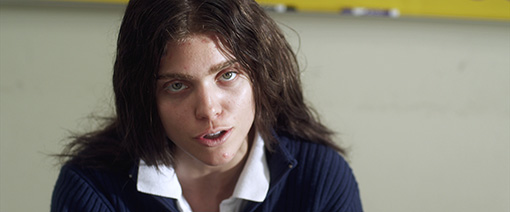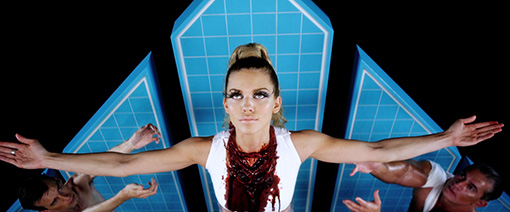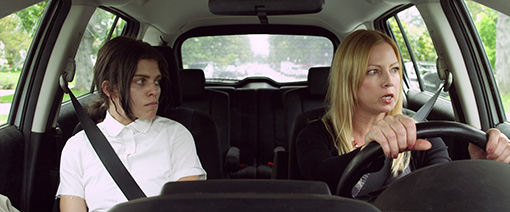|
Teenage Penelope has a few problems, at least according to her teachers, her classmates, her exasperated mother, the priest to whom she has been sent for counselling, and just about everyone with an opinion on how young girls should behave. She dresses to please no-one, lets her hair fall where it may, and says what she thinks with little or no regard for the reactions of others. In short, her main problem is that she doesn't fit in and refuses to modify her behaviour to do so. From the moment she sticks her hand up during a lesson on sexually transmitted diseases and asks if you can catch one by having sex with a dead person, I knew I was going to like her.
She's certainly not without her issues. Her dreams are violent and play out in the manner of glossily shot commercials for Freudian sex/death fantasies, and she's convinced that she is on the road to becoming a surgeon, based on little more than her fascination with blood. But she's quietly supportive of her younger sister Grace, whose cystic fibrosis has advanced to the point where her life could be on the line. And like so many teenagers of either gender, she's wrestling with issues of identity and acceptance in her own sweet, if unorthodox way.

Quite how we're supposed to react to Penelope is sometimes hard to judge, even with the aid of the accompanying commentary. In some ways she plays like an archetypal misfit – surly, spotty, untidy and unsociable, she too easily conforms to the Hollywood cliché that paints bad people in uglier colours than the superficially attractive representatives of regular society. That I liked her from the outset probably says as much about my own aversion to the social norms as it does about AnnaLynne McCord's superb central performance, as seductive an advert for surly rebellion as Brigitte from Ginger Snaps, to whom she sometimes feels organically bonded. It helps that almost everyone she kicks against has something about them that is worthy of active resistance, but none are played out to a cartoon extreme, which in the case of Penny's mother Phyllis allows us to occasionally share her frustration at her daughter's stubborn refusal to give an inch. This also gives rise to one of the most telling sequences, when a wits-end Phyllis complains bitterly to her easy-going husband Bob (who looks a bit like a young Oliver Stone), "I have tried and tried, but it is impossible to love her!", a proclamation that reduces the eavesdropping Penelope to tears.
There is, just occasionally, the suspicion that Excision was designed partly with future cult status in mind, particularly in the bit-part casting of such treasures as Traci Lords (superb as Penelope's mother), Malcolm McDowell, Ray Wise, Matthew Gray Gubler, and the lovely John Waters as patient clergyman William, a role that can't help but recall his memorable bit part as a paedophile priest in Herschell Gordon Lewis' Blood Feast 2: All U Can Eat (a convincing explanation for this casting is provided in the accompanying commentary, it should be noted). Visually it also stands out from the genre crowd, with director Richard Bates Jr. and his talented DP Itan Gross favouring brightly lit locked-down shots and super-smooth tracks, a welcome change from the current, grunge-tinted wobblecam norm. There's also a very formal approach to composition, the almost complete absence of angled shots creating the sense that the striking stylistics of Penelope's dreams are seeping into her real world and increasingly blurring the distinction between the two. And while the detectable influences are varied and numerous – ranging from Dario Argento to Tod Solondz – they are smoothly enough integrated into the overriding style to avoid playing like a mix-tape of past film favourites.

If there's a problem with classifying Excision as a horror movie it's that it doesn't really become one until the final ten minutes, which gives it the structural air of a classily shot episode of Hammer House of Horror. The dream and fantasy sequences are certainly bloody and their content extreme, but the heavily stylised manner in which they are presented tends to grace even the more horrific imagery with a dark but reality-distancing aesthetic beauty. That the final twist is telegraphed so far in advance may rob it of some of its shock-surprise value, but it still delivers one hell of a kick, and by then I had become so fond of Penelope and so concerned for her well-being that the prospect of what was to follow genuinely tore at my gut.
For a first feature, Excision is pretty damned impressive, in the confidence of its execution, in its refusal to walk the stylistic route of its genre compatriots, in its focus on character, and in the quality and conviction of its lead performances. Whether it quite deserves the acclaim that's been heaped on it in some quarters is another matter entirely. It's good, really good, and I'm already enthusiastic for whatever Bates Jr. delivers next, but I can't help thinking that those Twitter commentators who have proclaimed it the best horror movie they've ever seen really need to get out and see more horror movies.
Given that this was a low budget film funded by its director and his friends – and believe me, it never looks it – it comes as little surprise that it was shot digitally rather than on film, confirmed by a generous sprinkling of burned-out highlights. With that in mind, the image quality on the transfer is consistently impressive, the crispness of the detail, warm colour palette and attractive contrast range working particularly well for the stylised dream sequences, lending them a sheen that belies the film's budget. The real world sequences also look good – albeit with the above-mentioned highlight burn-out caveat – but exterior wide shots tend to look a tad sharper than interior mid-shots.

The DTS-HD Master Audio 5.1 surround track is bright, super-clear and impressively mixed, with a thumping good bass response when required and a subtle but effective use of the surrounds, particularly for Steve Damstra and Mads Heldtberg's atmospheric score.
Commentary
A lively and informative commentary in which director Richard Bates Jr. and lead actress AnnaLynne McCord recall the experience of making the film and share a number of sometimes amusing anecdotes. Bates outlines the difficulties he encountered in getting the film funded, the ways in which they managed to keep the costs down (having his former employer edit the film for free really helped), and the specific influences on his approach to individual sequences. It's not all good, however – as so often with modern commentaries, the list of scenes, images and actors they proclaim to love would fill a small notebook, and being young and American they use the word "awesome" often enough to make you want to slap them round the head with a weighty thesaurus.
Trailer (2:17)
A very nicely assembled trailer that manages to provide an accurate flavour of the film without giving too much away.
An auspicious debut feature that really does stand out from the current genre crowd, despite holding off on the real horror until the end, though the over-sensitive should still find plenty to get upset about in the dream scenes – one in particular has apparently prompted a few festival walkouts. The transfer is good and the commentary interesting (when it's not being "awesome"), and those with the stomach for bloody and taste-busting horror should definitely hunt it out, not least for the performances, the stylish handling, and that emotionally punishing final ten minutes.
|